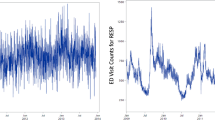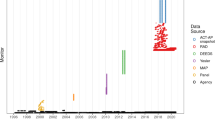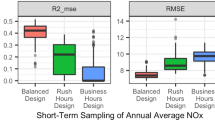Abstract
Regulatory monitoring data and land-use regression (LUR) models have been widely used for estimating individual exposure to ambient air pollution in epidemiologic studies. However, LUR models lack fine-scale temporal resolution for predicting acute exposure and regulatory monitoring provides daily concentrations, but fails to capture spatial variability within urban areas. This study coupled LUR models with continuous regulatory monitoring to predict daily ambient nitrogen dioxide (NO2) and particulate matter (PM2.5) at 50 homes in Windsor, Ontario. We compared predicted versus measured daily outdoor concentrations for 5 days in winter and 5 days in summer at each home. We also examined the implications of using modeled versus measured daily pollutant concentrations to predict daily lung function among asthmatic children living in those homes. Mixed effect analysis suggested that temporally refined LUR models explained a greater proportion of the spatial and temporal variance in daily household-level outdoor NO2 measurements compared with daily concentrations based on regulatory monitoring. Temporally refined LUR models captured 40% (summer) and 10% (winter) more of the spatial variance compared with regulatory monitoring data. Ambient PM2.5 showed little spatial variation; therefore, daily PM2.5 models were similar to regulatory monitoring data in the proportion of variance explained. Furthermore, effect estimates for forced expiratory volume in 1 s (FEV1) and peak expiratory flow (PEF) based on modeled pollutant concentrations were consistent with effects based on household-level measurements for NO2 and PM2.5. These results suggest that LUR modeling can be combined with continuous regulatory monitoring data to predict daily household-level exposure to ambient air pollution. Temporally refined LUR models provided a modest improvement in estimating daily household-level NO2 compared with regulatory monitoring data alone, suggesting that this approach could potentially improve exposure estimation for spatially heterogeneous pollutants. These findings have important implications for epidemiologic studies — in particular, for research focused on short-term exposure and health effects.
This is a preview of subscription content, access via your institution
Access options
Subscribe to this journal
Receive 6 print issues and online access
$259.00 per year
only $43.17 per issue
Buy this article
- Purchase on Springer Link
- Instant access to full article PDF
Prices may be subject to local taxes which are calculated during checkout





Similar content being viewed by others
References
Health Effects Institute 2010 Traffic-related air pollution: a critical review of the literature on emissions, exposure, and health effects. Special Report #17, 2010-01-12. Available on-line at http://pubs.healtheffects.org/view.php?id=334 (accessed 02/11/2010).
Wilson JG, Kingham S, Pearce J, Sturman AP . A review of intraurban variations in particulate air pollution: implications for epidemiological research. Atmospheric Environ 2005; 39: 6444–6462.
Weijers EP, Khlystov AY, Kos GPA, Erisman JW . Variability of Particulate matter concentrations along roads and motorways determined by a moving measurement unit. Atmospheric Environ 2004; 38: 2993–3002.
Westerdahl D, Fruin S, Sax T, Fine P, Sioutas C . Mobile platform measurements of ultrafine particles and associated pollutant concentrations on freeways and residential streets in Los Angeles. Atmospheric Environ 2005; 39: 3597–3610.
Isakov V, Touma J, Khlystov A . A method of assessing air toxics concentrations using mobile platform measurements. J Air Waste Manag Assoc 2007; 57: 1286–1295.
Breysse PN, Buckley TJ, Williams D, Beck CM, Jo SJ, Merriman B et al. Indoor exposures to air pollutants and allergens in the homes of asthmatic children in inner-city Baltimore. Environ Res 2005; 98: 167–176.
Diette GB, Hansel NN, Buckley TJ, Curtin-Brosnan J, Eggleston PA, Matsui EC et al. Home indoor pollutant exposures among inner-city children with and without asthma. Environ Health Perspect 2007; 115: 1665–1669.
Wheeler AJ, Xu X, Kulka R, You H, Wallace L, Mallach G et al. Windsor, Ontario exposure assessment study: design and methods validation of personal, indoor, and outdoor air pollution monitoring. J Air Waste Manag Assoc 2011; 61: 324–338.
Williams R, Rea A, Vette A, Croghan C, Whitaker D, Wilson H et al. The design and field implementation of the Detroit Exposure and Aerosol Research Study (DEARS). J Exp Sci Environ Epidemiol 2009; 19: 643–659.
Jerrett M, Arain A, Kanaroglou P, Beckerman B, Potoglou D, Sahsuvaroglu T et al. A review and evaluation of intraurban air pollution exposure models. J Exp Anal Environ Epidemiol 2005; 15: 185–204.
Boothe V, Dimmick WF, Talbot TO . Relating air quality to environmental public health tracking data. In: Aral MM, Brebbia CA, Maslia ML, Sinks T (eds). Environmental Exposure and Health vol. 85. Wessex Institute Transactions on Ecology and the Environment: Southampton, UK. 2005 pp 43–52.
Isakov V, Graham S, Burke J, Özkaynak H . Linking air quality and exposure models. Air Waste Manag Assoc Environ Manag 2006, 26–29.
McConnell RB, Berhane K, Yao L, Jerrett M, Lurmann F, Gilliland F et al. Traffic, susceptibility, and childhood asthma. Environ Health Perspect 2006; 114: 766–772.
Isakov V, Özkaynak H . A modeling methodology to support evaluation of public health impacts of air pollution reduction programs. Proceedings of the 29th International Technical Meeting on Air Pollution Modeling. Aveiro: Portugal. 2007.
Özkaynak H, Palma T, Touma JS, Thurman J . Modeling population exposures to outdoor sources of hazardous air pollutants. J Expo Sci Environ Epidemiol 2008; 18: 45–48.
Brauer M, Hoek G, Van Vliet P, Meliefste K, Fischer PH, Wijga A et al. Air pollution from traffic and the development of respiratory infections and asthmatic and allergic symptoms in children. Am J Respir Crit Care Med 2003; 166: 1092–1098.
Ross Z, English PB, Scalf R, Gunier R, Smorodinsky S, Wall S et al. Nitrogen dioxide prediction in Southern California using land use regression modeling: potential for environmental health analyses. J Expo Sci Environ Epidemiol 2006; 16: 106–114.
Jerrett M, Arain MA, Kanaroglou P, Beckerman B, Crouse D, Gilbert NL et al. Modeling the intraurban variability of ambient traffic pollution in Toronto, Canada. J Toxicol Environ Health 2007; 70: 200–212.
Ryan PH, LeMasters GKA . Review of land-use regression models for characterizing intraurban air pollution exposure. Inhal Toxicol 2007; 19 (Suppl 1): 127–133.
Hoek G, Beelen R, de Hoogh K, Vienneau D, Gulliver J, Fischer P et al. A review of land-use regression models to assess spatial variation of outdoor air pollution. Atmospheric Environ 2008; 42: 7561–7578.
Wheeler AJ, Smith-Doiron M, Xu X, Gilbert NL, Brook JR . Intra-urban variability of air pollution in Windsor, Ontario—measurement and modeling for human exposure assessment. Environ Res 2008; 106: 7–16.
Mukerjee S, Smith LA, Johnson MM, Neas LM, Stallings CA . Spatial analysis and land use regression of VOCs and NO2 from school-based urban air monitoring in Detroit/Dearborn, USA. Sci Total Environ 2009; 407: 4642–4651.
Vienneau D, de Hoogh K, Beelen R, Fischer P, Hoek G, Briggs D . Comparison of land-use regression models between Great Britain and the Netherlands. Atmospheric Environ 2010; 44: 688–696.
Luginaah IN, Xu I, Fung K, Grgicak-Mannion A, Wintermute J, Wheeler AJ et al. Establishing the spatial variability of ambient nitrogen dioxide in Windsor, Ontario. Int J Environ Stud 2006; 63: 487–500.
Grgicak-Mannion A, Wintermute J, Xu X, Wheeler AJ, Luginaah I, Brook J . Geospatial land use regression modelling: seasonal and yearly variation of NO2, PM2.5 and BTEX in Windsor, Ontario. Proceeding of 2007 ISEA International Conference 2007.
Environment Canada: www.ec.gc.ca/rnspa-naps/default.asp?lang=En&n=5C0D33CF-1 (accessed 18 June 2012).
Sather ME, Slonecker ET, Kronmiller KG, Williams DD, Daughtrey H, Mathew J . Evaluation of short-term Ogawa passive, photolytic, and federal reference method sampling devices for nitrogen oxides in El Paso and Houston, Texas. J Environ Monit 2006; 8: 558–563.
Demokritou P, Kavouras IG, Harrison D, Ferguson ST, Koutrakis P . Development and performance evaluation of a sampler for the chemical composition analysis of PM2.5. J Air Waste Manag Assoc 2001; 51: 514–523.
Rasmussen PE, MacIntyre DJ, Guenette J Buoyancy-Corrected Gravimetric Analysis System. United States Patent and Trademark Office. 2008, Patent. No. US 7,357,045 B2. Date: 15 April, 2008. 8 Claims, 3 Drawing Sheets http://patft.uspto.gov (accessed 18 June, 2012).
Rasmussen PE, Gardner HD, Niu J . Buoyancy-corrected gravimetric analysis of lightly loaded filters. J Air Waste Manag Assoc 2010; 60: 1065–1077.
Dales R, Wheeler A, Mahmud M, Frescura AM, Smith-Doiron M, Nethery E et al. The influence of living near roadways on spirometry and exhaled nitric oxide in elementary schoolchildren. Environ Health Perspect 2008; 116: 1423–1427.
Dales R, Wheeler AJ, Mahmud M, Frescura AM, Liu L . The influence of neighborhood roadways on respiratory symptoms among elementary schoolchildren. J Occup Environ Med 2009; 51: 654–660.
Liu L, Poon R, Chen L, Frescura AM, Montuschi P, Ciabattoni G et al. Acute effects of air pollution on pulmonary function, airway inflammation, and oxidative stress in asthmatic children. Environ Health Perspect 2009; 117: 668–674.
Gulliver J, Morris C, Lee K, Vienneau D, Briggs D, Hansell A . Land use regression modeling to estimate historic (1962-1991) concentrations of black smoke and sulfur dioxide for Great Britain. Environ Sci Technol 2011; 45: 3526–3532.
Chen H, Goldberg MS, Crouse DL, Burnett RT, Jerrett M, Villeneuve PJ et al. Back-extrapolation of estimates of exposure from current land-use regression models. Atmospheric Environ 2010; 44: 4346–4354.
Clark NA, Demers PA, Karr CJ, Koehoorn M, Lencar C, Tamburic L et al. Effect of early life exposure to air pollution on development of childhood asthma. Environ Health Perspect 2010; 118: 284–290.
Mölter A, Lindley S, de Vocht F, Simpson A, Agius R . Modelling air pollution for epidemiologic research—Part II: predicting temporal variation through land use regression. Sci Total Environ 2010; 409: 211–217.
Nethery E, Leckie SE, Teschke K, Brauer M . From measures to models: an evaluation of air pollution exposure assessment for epidemiological; studies of pregnant women. J Occup Environ Med 2008; 65: 579–586.
Aguilera I, Guxens M, Garcia-Esteban R, Corbella T, Nieuwenhuijsen MJ, Foradada CM et al. Association between GIS-based exposure to urban air pollution during pregnancy and birth Weight in the INMA sabadell cohort. Environ Health Perspect 2009; 117: 1322–1327.
Llop S, Ballester SF, Estarlich M, Esplugues A, Rebagliato M . Carmen Iñiguez. Preterm birth and exposure to air pollutants during pregnancy. Environ Res 2010; 110: 778–785.
Gehring U, Wijga AH, Fischer P, de Jongste JC, Kerkhof M, Koppelman GH et al. Traffic-related air pollution, preterm birth and term birthweight in the PIAMA birth cohort study. Environ Res 2011a; 111: 125–135.
Gehring U, van Eijsden M, Dijkema MBA, van der Wal MF, Fischer P, Brunekreef B . Traffic-related air pollution and pregnancy outcomes in the Dutch ABCD birth cohort study. Occup Environ Med 2011b; 68: 36–43.
Rudra CB, Williams MA, Lianne Sheppard L, Koenig JQ, Schiff MA . Ambient carbon monoxide and fine particulate matter in relation to preeclampsia and preterm delivery in western Washington state. Environ Health Perspect 2011; 119: 886–892.
Novotny EV, Bechle MJ, Millet DB, Marshall JD . National satellite-based land-use regression: NO2 in the United States. Environ Sci Technol 2011; 45: 4407–4414.
Kloog I, Koutrakis P, Coull BA, Lee HJ, Schwartz J . Assessing temporally and spatially resolved PM2.5 exposures for epidemiological studies using satellite aerosol optical depth measurements. Atmospheric Environ 2011; 45: 6267–6275.
Su JG, Brauer M, Bc Ainslie, Steyn D, Larson T, Buzzelli M . An innovative land use regression model incorporating meteorology for exposure analysis. Sci Total Environ 2008; 390: 520–529.
Noth EM, Hammond SK, Biging GS, Tager IB . A spatial-temporal regression model to predict daily outdoor residential PAH concentrations in an epidemiologic study in Fresno, CA. Atmospheric Environ 2011; 45: 2394e2403.
Cakmak S, Mahmud M, Grgicak-Mannion A, Dales RE . The influence of neighborhood traffic density on the respiratory health of elementary schoolchildren. Environment Int 2012; 39: 128–132.
Liu LJ, Tsai MY, Keidel D, Gemperli A, Ineichen A, Hazenkamp-von Arx M et al. Long-term exposure models for traffic related NO2 across geographically diverse areas over separate years. Atmospheric Environ 2011; 46: 460–471.
Crouse DL, Goldberg MS, Ross NA . A prediction-based approach to modelling temporal and spatial variability of traffic-related air pollution in Montreal, Canada. Atmospheric Environ 2009; 43: 5075–5084.
Acknowledgements
We would like to thank the scientists and field technicians who contributed to this study including Li Chen, Hongyu You, Ryan Kulka, Keith Van Ryswyk, Corrine Stocco, and Angelos Anastassopoulos (Health Canada). We also received helpful feedback on the draft manuscript from Nina Dobbins and Rick Burnett. Finally, we would like to thank the household participants without whom this study would not have been possible.
Author information
Authors and Affiliations
Corresponding author
Rights and permissions
About this article
Cite this article
Johnson, M., MacNeill, M., Grgicak-Mannion, A. et al. Development of temporally refined land-use regression models predicting daily household-level air pollution in a panel study of lung function among asthmatic children. J Expo Sci Environ Epidemiol 23, 259–267 (2013). https://doi.org/10.1038/jes.2013.1
Received:
Accepted:
Published:
Issue Date:
DOI: https://doi.org/10.1038/jes.2013.1
Keywords
This article is cited by
-
Spatial and temporal estimation of air pollutants in New York City: exposure assignment for use in a birth outcomes study
Environmental Health (2013)
-
Development and evaluation of alternative approaches for exposure assessment of multiple air pollutants in Atlanta, Georgia
Journal of Exposure Science & Environmental Epidemiology (2013)



